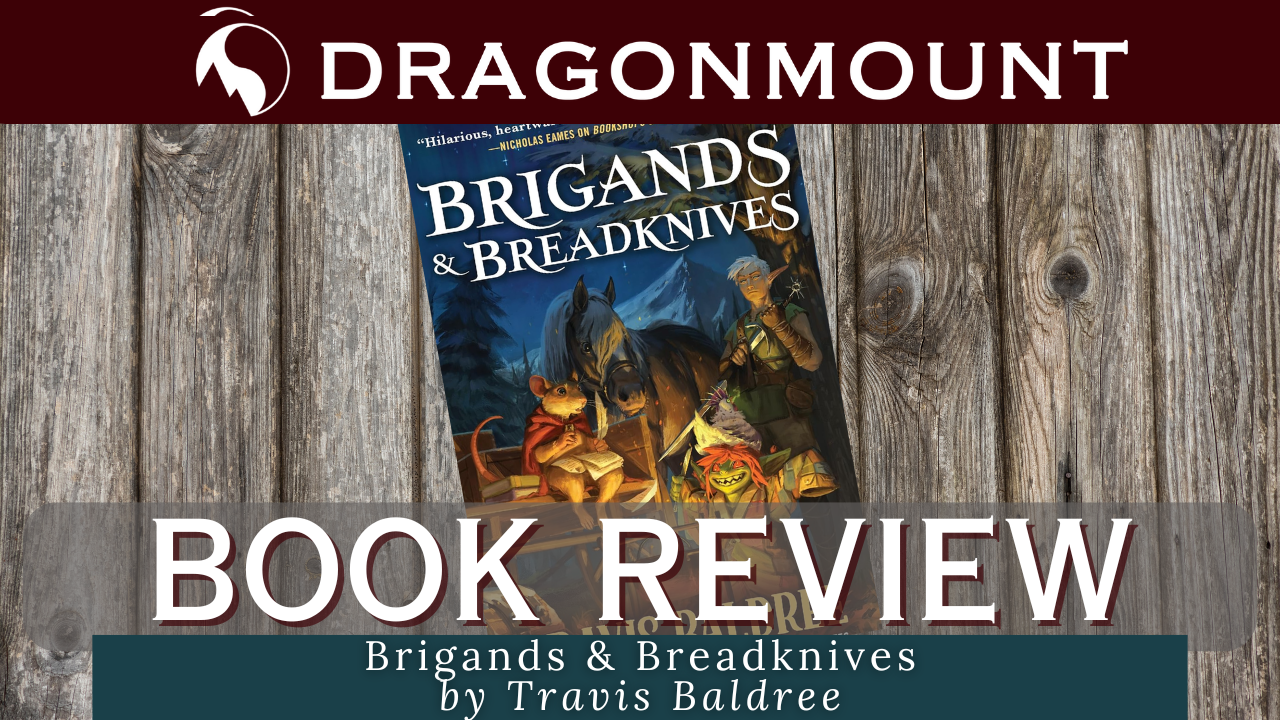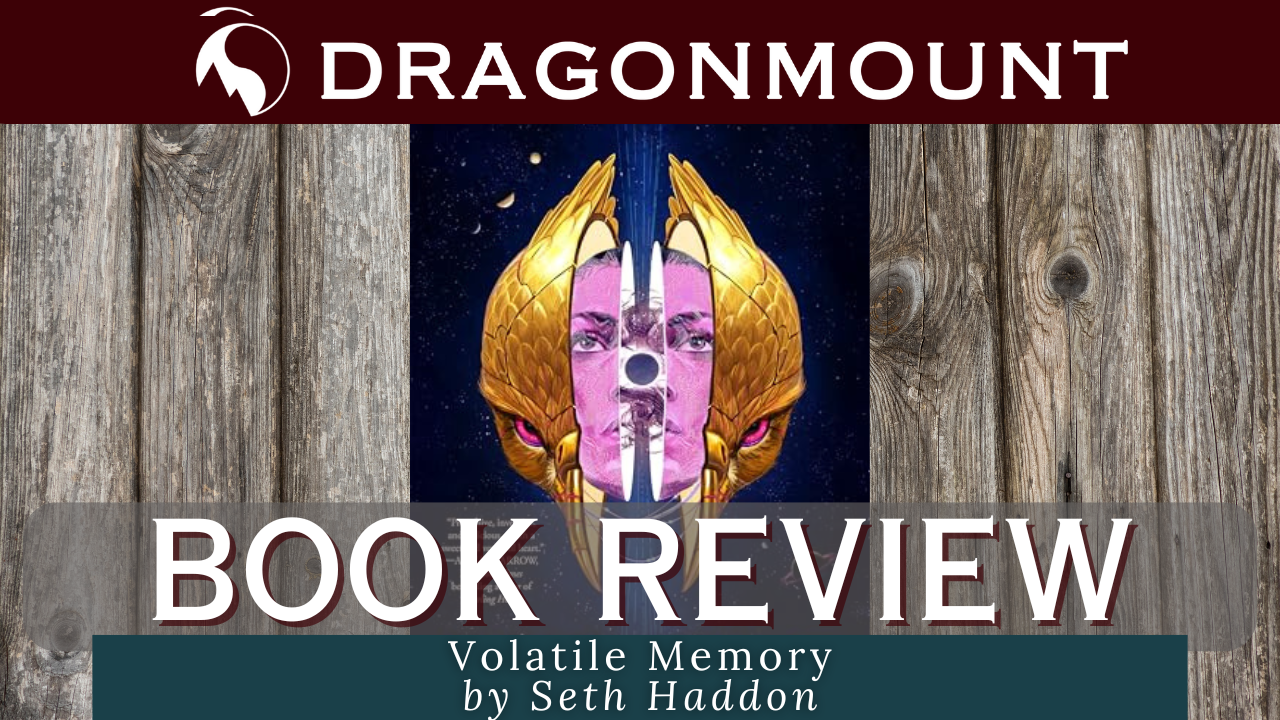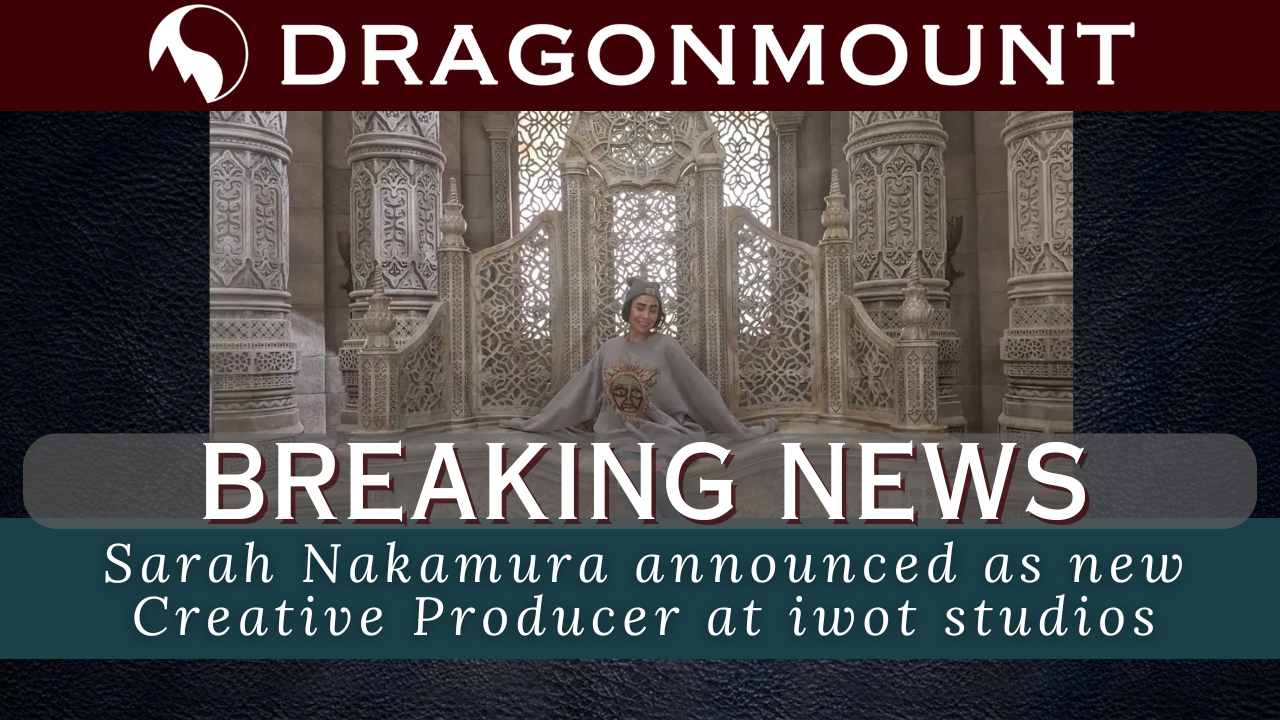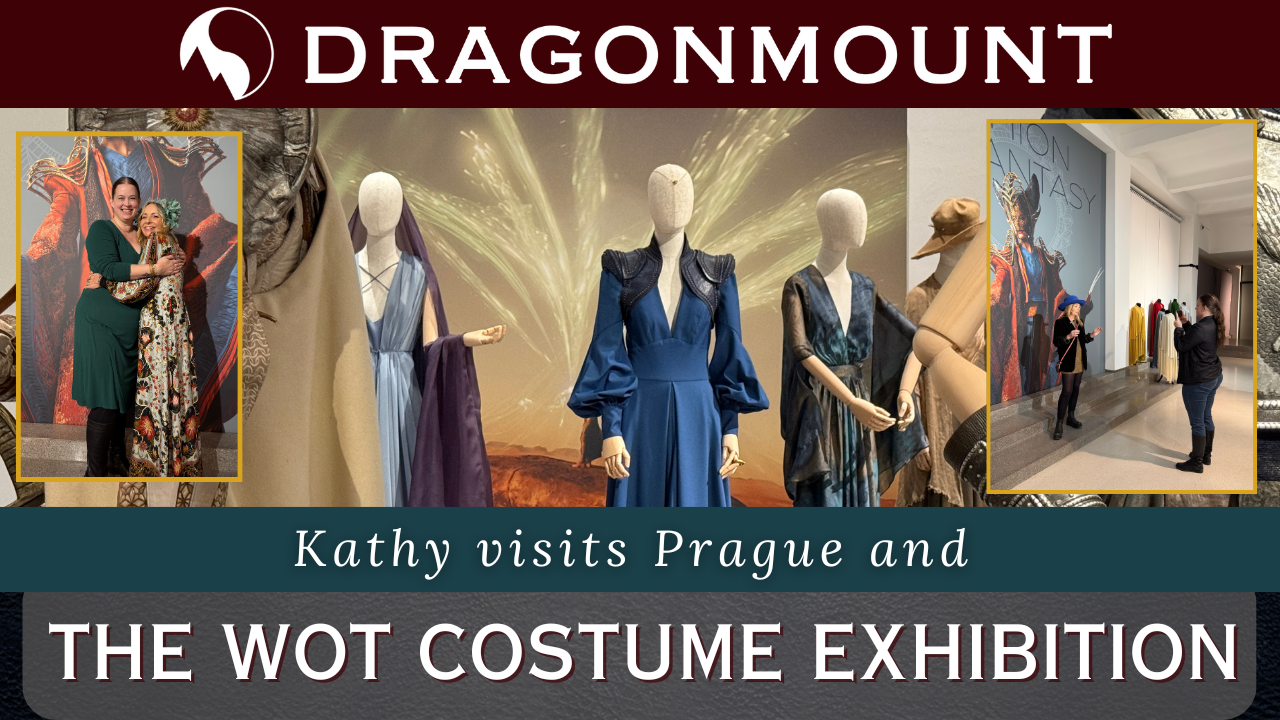News items
The Wheel of Time costume exhibition at Prague's Galerie Manes showcases over 80 breathtaking costumes, offering an unprecedented look at the intricate craftsmanship behind the show.
Read More...
I’m not sure if “cozy midlife crisis burnout fantasy” is a genre, but across the excellent Legends & Lattes series, Travis Baldree has certainly had enough characters experience it. Fern, the sweary rattkin bookseller from the previous tale, “Bookshops & Bonedust”, has moved across the lands and opened up a shop right next door to the titular Legends & Lattes cafe. She has the help and support of her old friend Viv and the local community. On parchment, it all sounds perfect, but she feels increasingly unfulfilled with the weight of this new life pressing down on her. One drunken night of very much not dealing with things leads to her “accidentally” waking up in the back of the cart of a thousand-year-old elf warrior, Astryx, far away from her friends and rapidly heading in the opposite direction from them, and conveniently, also from her problems. Astryx is a by-the-book bounty hunter, also in her later years, who is escorting a goblin prisoner Zyll to face justice. Some of you may remember Zyll from the short story “Goblins & Greatcoats”, and know she is truly a force of chaos. Both Fern and Astryx have to come to terms with what they actually want to do with their lives on the journey, with Zyll being an effective catalyst. Despite being set in the same world as the book that arguably popularised the whole cosy fantasy genre, this is measurably less cozy than the other two in the series, with a lot more action along the way. The first two books were essentially about running a rather familiar small business in a sword and sorcery world, and this is more of your typical epic road trip adventure. It’s also notably not really a romance either, and not queer, even though we get to see some of Viv and Tandri at the start of the book. However, keeping both of those things in mind, it is still very enjoyable, with echoes of the wonderful work of Terry Pratchett. Highly recommended, even if you’re not currently having a midlife crisis. Don't forget, you can pick this up in our ebook store!
.png.9f5c9592d957aef477c7444898ff90e3.png)
Nearly four months have passed since the unceremonious cancellation of The Wheel of Time show. Despite virtually no known news or movement behind the scenes, fans of the show remain passionate and continue to share their hopes of the show being saved. And through those four long months, one voice among the cast and crew has been there consistently, championing our passion with her own: Sharon Gilham. Those familiar with Sharon's instagram page are more than aware that she has been an unending source of behind the scenes photos and videos for Season 2 & 3 of The Wheel of Time. Through the SAG/AFTRA & WGA strikes, when virtually no promotion could be done for the show, Sharon continued to post new reels, photosets, mood boards, and concept art. To say that she is as passionate as we are wouldn't do her justice. If you were lucky enough to attend WotCon 2025, you would have also had the chance to see some of her costume designs from the Season 3 Finale on display, maybe you even had a chance to talk to her like I did! Well if you missed that chance, or if even if you didn't, Sharon has yet another gift for us all. Beginning November 14th through December 5th, there will be an official Costume Exhibition in Gallery Manes, Prague, featuring over 80 costumes from The Wheel of Time! Not only will you get to SEE the costumes in person, you will also gain insight into each stage of the design and making process, including sketches, prototypes, interviews with the design team and crafts people. You can find out more, and RSVP for your spot, at the link here! "But Kevin, I don't live anywhere near Prague and could never get there in time!" Ah, fear not, humble reader! Sharon herself, in the comments of the post announcing this event, stated: "I'm hoping if this is a success we could tour it globally..." So, you have your mission: Spread the news far and wide! Help make this event a success, and MAYBE they could come to a city near you! And thank you, Sharon, for being so gracious with sharing your creativity with us and the world. Follow the official instagram account for the exhibit here for future updates!

If you think you would enjoy a light and humorous fantasy series with a central sapphic romance, and you’ve not yet even checked out the first book “You Can’t Spell Treason Without Tea”, stop reading this review right now and go start there. What sort of person are you? Do you look at the last page of a book before you start reading to make sure there’s a happy ending? Go away! (There is, by the way.) Rogue alchemists have kidnapped Reyna, the Queensguard-turned-Queen, right after her wedding to Kianthe, the most powerful mage in the country. Given that particular set of volatile ingredients, they are certainly going to get a big reaction! (Because alchemy. Never mind.) Worse than that pun, due to their combined fame across the lands, the town of Tawney is now getting a touch too popular as a tourist destination, which is causing problems for everyone around them. There’s one obvious solution, and that’s closing their beloved tea shop for good and moving away. Reyna doesn’t stay kidnapped for very long of course, and as part of the investigation into who exactly was behind it, our pair end up spending a lot of time at the Magicary, home of the Stone of Seeing. With all the focus on the Queendom last time, it’s fun to see Reyna on Kianthe’s home turf here. The tensions between the Mages and the Alchemists are well done with their two wildly different approaches to magic, and the resulting prejudices and misunderstandings. I am on record as enjoying all the previous books in this series, so when Rebecca Thorne said this was the best one yet, it is fair to say that my expectations were suitably raised. I’m glad to say that it delivers on both a fun new adventure, as well as a satisfying end to the series. It wraps up a wide number of things, including the fate of the last missing dragon egg from book one. There is one outstanding unanswered question at the end however, concerning the whereabouts of a particular person, so I am not entirely convinced this is the last we will ever see of Tawney and these wonderful characters. At least, I hope not. It’s always a good feeling when you can recommend a whole completed series, and I can now do so without reservation! Don't forget, you can pick this up in our ebook store!

Wylla Sotain is a scavenger, living day by day, and searching for the elusive big score that will allow her to finally repair her ship and drag herself out of poverty in an uncaring galaxy. In this particular future, people wear AI-powered masks to enhance their abilities. Wylla has a battered old MARK I RABBIT, which means her senses are heightened, like the prey animal she is. It seems like her fortunes are about to change when she finds the MARK I HAWK mask—an expensive prototype that should not exist—lying on the face of a dead woman called Sable Veonya. When she puts the mask on, Sable talks to her and remembers being murdered. Now everybody is looking for them, including VisorForge, the corporation that is responsible for the masks, and the other scavengers who want a piece of the action. The book is told in second person perspective, with Sable talking to you, the reader, as if you were Wylla. Harrow the Ninth readers will be quite familiar with this format. Wylla is trans and has been fighting the system her whole life. Sable, on the other hand, now has no body at all. They both accept each other quickly, and a relationship develops between the two of them while they try to track down Sable’s killer, and avoid the authorities. There are so many enjoyable and unique ideas here, and the plot moves very quickly. I do wish this was a full length novel, so the story had a bit more time to breathe, and the romance could develop slightly more naturally over time. As it is though, you can probably read this in one sitting, and get the whole thing downloaded into your brain near-instantaneously. Which, honestly, seems quite fitting. Recommended! Don't forget, you can pick this up in our ebook store!

The Prestige by Christopher Priest (originally published in 1995) Reviewed for Dragonmount by Michael When Tor approached Dragonmount and asked if anyone would be available to read and review The Prestige by Christopher Priest, I jumped at the chance. Well, after my mind went through the inevitable jumps of “wait, like the movie?” and “ok, but that book came out in 1995!” Those are all correct thoughts: the Christopher Nolan film starring Christian Bale and Hugh Jackman is based upon this book, which was released in 1995. But Tor is re-releasing the book as part of the Tor Essentials collection, and if that is not good enough reason to revisit it, the fact that Christopher Priest passed away in 2024 is. Despite having seen the movie two or three times, I had not read the book before (a reversal of the order I usually prefer to do things). As soon as I had the advance copy in my hands and started reading, I understood why Christopher Nolan had been drawn to this story. The text plays with timing and narrative in the same way that has become a hallmark of Nolan’s films, but with varied elements that are available in the written vs. the visual form. At times, I was stylistically reminded of the way Grey Men are handled in the Wheel of Time—right there on the page, but hidden in plain sight until their presence is revealed and you can revisit that paragraph with knowing eyes. The Prestige is divided into five parts, told from the first-person perspective of four different characters: the two magicians, Alfred Borden and Rupert Angier; two modern-day (or at least, modern as of 1995) descendents of those men, Andrew Wesley (Borden) and Kate Angiers; and, finally, a brief look at the title character. Each perspective is written in a different voice and style, to great effect. The modern contemporaries are presented as a standard first person narratives, as those characters work together to try to understand the overlapping family histories and the dramatic obsession that existed between their great-grandfathers. The accounts of the magicians are as written journals, Borden’s as an adult journal of his work and Angier’s as a diary (begun on his ninth birthday) of his life. Neither are entirely reliable narrators, for reasons that will become more clear upon finishing the book. Beginning as a sort of mystery and becoming a tale of obsession and competition with tragic results, The Prestige ends as a horror. Indeed, the final lines of The Prestige strongly evoke the final lines of another Victorian science-fiction horror: Frankenstein by Mary Shelley. I found the slow build toward both science-fiction and horror to be highly effective. At the beginning, we are with a modern human, with cell phones and CDs, and with a casual interest in understanding more about his family history. As we learn about the lives of the two magicians, we begin to appreciate the terrible toll that their obsessions—with magic, with each other, with revenge—takes on themselves and their families. By the end, the sins of the past have manifested in the present, and the truly sinister nature of The Prestige is revealed. SPOILERS AHEAD Because the film adaptation was successful, I suspect that I may not be alone in having come to this book having some idea of the plot and foreknowledge of the surprising twists. While the plot is more or less the same, and those twists are still present, the treatment and the nuances of the book The Prestige are significantly different. I do not need to unpack every difference, but there are a few elements of the book that I especially want to make note of, and in many cases these are also instances that diverge from the film. The double life of Borden is handled superbly, as even the character never explicitly admits to the existence of an identical twin. Both contribute to “his” journal as the same person, and only occasionally reference “The Pact” which prevents them from sharing particular details. Only after Angiers discovers their secret, after our time with Borden’s journal has ended, do the final pieces of how his Transported Man illusion is able to work, and why his personal life was conflicted, as if between two personalities. Likewise, Angier is equally cagey about the specifics of his Transported Man. He alludes only vaguely to the unpleasantness of dealing with “the prestige materials” that are generated by his use of the apparatus designed by Tesla. It is left to the descendents of the magicians to truly uncover and understand the terrible price that Angier paid for his magic trick. It is the connection to modern times that produces the most horrifying effect. The movie ends tragically with the deaths of one and a half of the rival magicians, but with a final happy ending scene of “Alfred Borden” being reunited with his daughter and (as per Christopher Nolan’s usual) Michael Caine looking on approvingly. The book ends rather differently, and with a much more menacing emphasis on the title. Ultimately, I highly recommend reading The Prestige by Christopher Priest. Fans of the film will find plenty new and different to appreciate here, and if you have not seen the movie, I am truly jealous that you may get to experience the twists and turns of this story from the page for the first time. And, anyone who has ever driven to Denver by way of Iowa and Nebraska will find some relatably amusing lines on page 232 of this new Tor Essentials edition! Thank you, as always, to Tor Publishing for the advance access to this book.

A Far Better Thing by H.G. Parry Reviewed for Dragonmount by Michael eBook available It was the best of times, it was the worst of times. It was the summer of brat, it was the winter of despair. It is a gilded age of desperation as the wealthy enrich themselves at the expense of the everyperson. . . It feels appropriate to revisit A Tale of Two Cities in the Year of our Lady 2025. Charles Dickens’ classic story set during the French Revolution against the towering backdrop of Le Guillotine, examines the lengths that people will go to for both love and revenge. A Far Better Thing, by H. G. Parry, puts a Fae twist on the story, asking “what if Sydney Carton was Charles Darnay’s fairy changeling?” Now, if either of those names, or the names of the Defarges; Miss Pross; Messers Cruncher, Stryver, Lorry, or Barsad, are unfamiliar to you—even if you have read A Tale of Two Cities at some point in your life—I'm going to suggest that you do what I did, and begin by reading or rereading the original work. (If you're into audiobooks, it's free to listen to on THAT app…) I know that I read the Wishbone version, and the Great Illustrated Classics version, and I think that I also read the full text at one point in my youth. However, it has been a while and I remembered only the broadest strokes: Sydney Carton is a brilliant but troubled lawyer, Madame Defarge is a quietly terrifying menace with her knitting, and the story ends with Carton going to the Guillotine in place of the innocent Charles Darnay. Spoiler alert for the 1859 book, A Tale of Two Cities… Rereading the original was a powerful experience. Dickens is one of the greats for a reason and his prose absolutely flows, barely slowed by the linguistic differences in the style that 150+ years will do. Even though I knew the ending was coming, the last several pages had me in tears as Sydney Carton holds the young girl’s hand and comforts her as they approach their final moments. The machinations of the Defarges as their, and especially Madame’s, need for vengeance cannot be sated and goes from righteous to monstrous; the quiet strength of Lucie Manette as she bears the love of so many; the bottomless self-loathing and destruction of the brilliant Carton all explore complex dimensions of humanity in timeless fashion. The introduction to the audiobook by actor Simon Callow claims that Dickens sacrificed some of his famous character building for the sake of telling a larger story of, well, two cities. Hearing that, I questioned it a bit—Madame Defarge? And Sydney Carton? Iconic characters, at the best and worst of times! While it is true that the characters in A Tale of Two Cities are complex, they are presented essentially as is. We especially do not get a satisfactory explanation as to why Sydney Carton is so miserable in his life. A Far Better Thing fleshes out these characters, exploring motivations and subtleties that are indeed missing from the original text. A Far Better Thing is told from Carton’s perspective, and we quickly discover that he was taken from his cradle as an infant and raised in the Faerie realm to be a servant of the Fae. Returned to the mortal realms, his servitude consists primarily of having to help the Faeries abduct other infants. There are some additional details which are better explored in the pages of the book, but this despicable task alone is sufficient to understand why Carton may have a bit of self-loathing. Reading the premise of A Far Better Thing, which is described as “Jonathan Strange and Mr. Norrell meets A Tale of Two Cities,” I was curious to see what a fantasy retelling of a classic novel looked like. Would this book replace the events of the original? Was it a close retelling or an “inspired by” situation? The actuality is that the two books can exist as canon simultaneously, for we quickly learn that most mortals—including most of Dickens’ characters—are not aware of the Fae presence. Essentially, A Tale of Two Cities is the “Muggle” telling of the story and A Far Better Thing is the magical side of the story. Our narrator, being intimately connected to both the Faerie and mortal realms, can guide us readers through the intricacies of the overlap. Dickens, for all of the magic behind his pen, did not have these insights and could only relay the mortal version of the story. Reading the two tales back-to-back generated the effect of a detective explaining howandwhodunnit at the end of a good mystery. All of the events that we saw with one set of eyes are now explored with a second set, revealing details that we missed or could not have known. The depth of pain and love in Sydney Carton’s heart is explored in wrenching detail, and his sacrifice at the end strikes the reader even harder as the full scope of his redemption is revealed. The events of A Tale of Two Cities appear almost exactly as they do in the original, but because we are in Carton’s POV, and he is not featured on every page of Dickens’ work, we are treated to some original action and characters that allow Parry’s storytelling and prose to shine. The prose pays homage to Dickens’ writing style, and Parry’s expert familiarity (her PhD is in English literature) with the source material is evident. If I am to find criticism—and I truly have to plumb the depths to do so—I will say that the final moments, the final sentence even, left me wanting to read the titular line. Although I understand that a retelling should be just that, I finished the book wanting to read that iconic last sentence of A Tale of Two Cities: “It is a far, far better thing that I do, than I have ever done; it is a far, far better rest that I go to, than I have ever known.” I think it would have hit the same, powerful mark but far deeper after spending so much time with the deeds and misrest of Sydney Carton. There is, also, a slight timeline issue which I only raise as a persnickety editorial type, but at one point Carton’s vision is blurring and he describes the world as looking “like an Impressionist painting.” Beautiful imagery, especially in the setting of Paris, but the Impressionist movement did not begin until the 1860s, and the events surrounding the French Revolution took place in the late 1700s. Overall, A Far Better Thing is a beautiful, fun, and creative read. I enjoyed that it led me to rediscover A Tale of Two Cities (I cannot recommend enough reading the original first), and it more than succeeds in the ambitious undertaking of improving upon a certified classic.

As the dust continues to settle from the cancellation of The Wheel of Time show, and the fans continue to make waves in hopes for a savior, a familiar name is making moves of her own. Rick Selvage, the CEO of iwot studios, has announced that Sarah Nakamura, story and loremaster consultant for the aforementioned WoT show, has joined the company as Creative Producer, focused on Narrative & Engagement. In this new role, Sarah will oversee the narrative development, brand storytelling, and fan engagement across all iwot studio initiatives, as well as represent iwot studios at all fan conventions and industry conferences worldwide. In addition to this, there will also be a new forthcoming Wheel of Time branded video podcast series, hosted by Sarah Nakamura, which will feature: Exclusive updates and behind-the-scenes access to iwot studios projects Interviews with directors, actors, game developers, and more! Sarah Nakamura provided comment on this news, saying: “For three seasons, I served as a story and lore consultant on the highly successful Sony/[Prime Video] series, always focused on fidelity to canon. That experience prepared me for this new role, where I’ll guide creative decisions and ensure every project remains true to the heart and mythology of the series. I’ve loved this world for as long as I can remember, and it’s an honor to help bring it to life in new, immersive ways.” iwot studios, formerly known as Red Eagle Entertainment, is perhaps most well known within the fandom for the (rather obscure) first attempted pilot for The Wheel of Time, titled ‘Winter Dragon’ (2015). Following the initial success of the show on Prime Video, many new projects and productions from the iwot team have been announced that, as of yet, have not come to fruition. With the addition of Sarah Nakamura to the team, one can hope that this could breathe new life and enthusiasm for the projects iwot has in the works for The Wheel of Time universe, which currently includes: Age of Legends, a live action origin film directed by award-winning filmmaker Kari Skogland The White Tower, A 3D animated feature in collaboration with Quebec’s acclaimed Squeeze Animation Studios An ambitious AAA game from iwot sames (sister division of iwot productions), which claims to be an “open world RPG set in The Wheel of Time universe” Rick Selvage commented on the decision to add Sarah to their team, stating: “Sarah’s experience, expertise, and deep passion for The Wheel of Time make her the ideal person to guide our transmedia creative efforts. Her commitment to preserving the integrity of the series is unmatched, and we’re thrilled to welcome her back to the team.” As of now, there is no reported timeline or expectation on when fans should hope to see any of these projects manifest on their screens. The cancellation of The Wheel of Time on Prime Video has done no favors to the expectations fans have for the future of The Wheel of Time media beyond the books, but perhaps the addition of Sarah will be the spark that is needed to see these projects through. We wish nothing but the best for Sarah, and hope she finds success and fulfillment in her new ventures with iwot studios!

“Bury my bones in the midnight soil. Plant them shallow and water them deep. And in my place will grow a feral rose.” This book is told from the perspectives of María in 1532, Charlotte in 1827, and Alice in a much more familiar 2019. All three are swept away from their mundane lives by equally enigmatic women, and find themselves with no pulse, an unquenchable thirst, and remarkably less patience with the ways of men. Three feral roses with rather sharp thorns. We see the most of María through the years, learning how to be a vampire without any form of instruction, and constantly reinventing herself as she travels across the world and the centuries. Some of her victims deserve it. Some. Alice at least has the benefit of already knowing what a vampire is from pop culture, as well as having ready access to the internet, but even she is entirely unprepared for what is happening to her. As the reader, we become increasingly complicit in the crimes of our vampire trio, urging them on at first, until we realise perhaps too late that things are getting a bit out of hand. Even Alice, who is the closest to still being a good person here, is still ripping out throats with gay abandon. So, varying degrees of villainy all round, but they are always entertaining. Eventually, the stories begin to overlap, and there is a very satisfying payoff for all the backstory. This is a wonderfully written modern take on the vampire genre, and along with “Hungerstone” by Kat Dunn, we’re definitely having a great year for sapphic exsanguination. Highly recommended for all blood types! Don't forget, you can pick this up in our ebook store!

Ever since the announcement of the cancellation of the Wheel of Time on Prime Video, our world has been in turmoil. Here at Dragonmount, we’ve been grieving and trying to wrap our minds around what this means for the future. We are so proud to be in this Statistically the Best fandom and to have seen the outpouring of love and passion given to the community and the desire to keep telling the story. Rumors swirl, of course, and you may have seen reporting that this cancellation is the final line in this story. However, showrunner Rafe Judkins expressed hope in an eloquent Instagram post that the show will “do what the books have always managed to do since day one—defy the traditional definitions of ‘beginnings and ends.’” Thankfully, our friends in the Wheel of Time community have not been hit by the freezing mindset. Instead, they—and us—have chosen to fight. Every voice helps, and if you want to get involved, here is what you can do: Visit savewot.com to sign the petition and get information to send letters urging other studios to take up the show. Access the Go Fund Me that is raising money for a publicity campaign to put up billboards all over the world to help Save the Wheel of Time. Already, almost $20,000 has been raised, demonstrating the intense love that our community feels for this show. We know there are a lot of feelings happening right now. But we are so grateful for everyone in this community and the hard work they’re putting into this, making sure that the world knows what we’re begging for! The story is not over. We stand by, ready to head to Tarmon Gaidon and let this story that is so passionately loved by so many be finished in the way it deserves to be told.

Join our Patreon here! The new Patreon now includes access to: Exclusive WoT content and Maria "RAFO" Simons Q&A. Dragonmount-hosted game servers for community play. Live guest chats, behind-the-scenes footage, outtakes, and more. Special Legacy supporter tags for anyone who supported us before the relaunch! More Discord perks, live game nights, and even a say in future Dragonmount content. Check it out, join us, and become part of a more involved Wheel of Time community with the rest of us die-hard fans!















